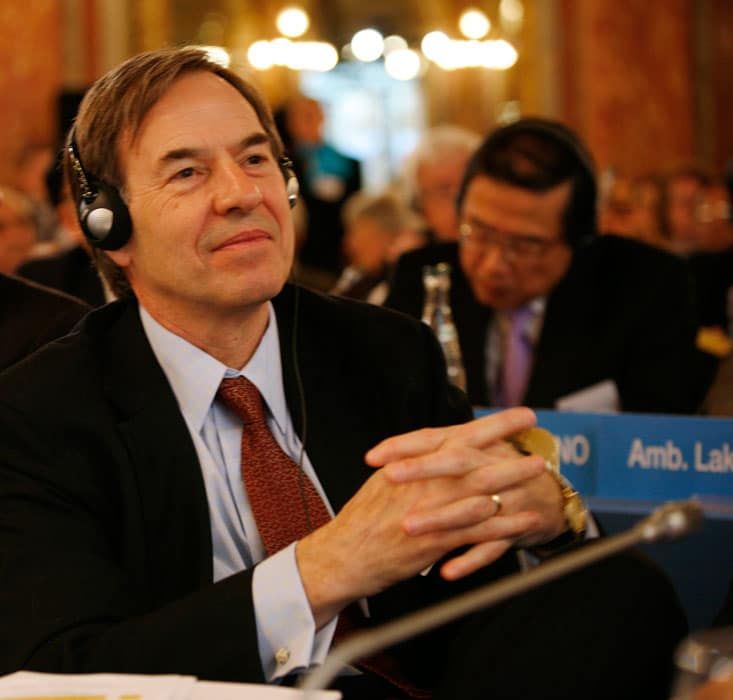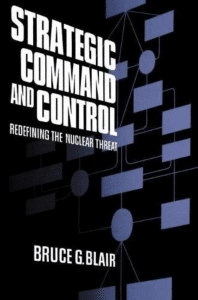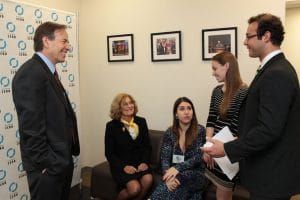Bruce Blair: Challenging the accidental nuclear war machine at every turn
By Jessica Sleight, Zia Mian, Frank von Hippel | August 11, 2020
 Bruce Blair at the 2010 Global Zero Summit in Paris.
Bruce Blair at the 2010 Global Zero Summit in Paris.
Bruce Blair spent his professional life working to expose the dangers from the nuclear Doomsday Machine created by the United States and Soviet Union during their Cold War and advancing policies to reduce the risk of nuclear use. A leading expert on nuclear command and control, he focused especially on the risks of accidental nuclear war implicit in the “hair-trigger” postures of US and Soviet ballistic missiles. During his final 15 years, he led a campaign for the phased and verifiable elimination of all nuclear weapons. He died on July 19 at the age of 72 as a result of a severe stroke.
With Blair’s death, the nuclear-disarmament movement has lost one of its most learned, creative and persistent leaders. The challenges of nuclear disarmament and, in the interim, reducing the danger of nuclear war, remain. Sadly, we must now carry on without Blair’s extraordinary focus, leadership, and innovative institution building. Those of us who have had the privilege of working with him will continue to be inspired by his quiet but dogged and comprehensive commitment to the mission.
Minuteman launch control officer. After graduating from the University of Illinois with a degree in communications, Blair served in the US Air Force from 1970 to 1974. He spent one year at Strategic Command’s headquarters in Nebraska as a support officer for the “Looking Glass” airborne command post. During the Cold War, one of these aircraft was in the air at all times and could launch the 1,000 US Minuteman missiles scattered over the northern Great Plains in case some of their launch-control facilities failed or were destroyed.
From 1972 to 1974, he served at Malmstrom Air Force Base in Montana as a launch control officer for a group of 50 Minuteman II intercontinental ballistic missiles. His underground launch-control center also served as an alternate command post for the full wing of 200 missiles. Each Minuteman II, housed in a reinforced-concrete underground “silo,” carried a single nuclear warhead with roughly 80 times the power of the Hiroshima warhead.
Reflecting on his experience of training, practicing, and rehearsing to launch the missiles in “about 100 nuclear wars in mock underground launch centers,” Blair realized, “We had been conditioned, like Pavlov’s dogs, to expect certain war orders to flow in a certain sequence, culminating in the launch of all 50 missiles… Everything else was above our pay grade. No little lights of conscience flickered in our minds. Launch officers in their early twenties, like myself, rarely struggled with the moral question of following orders that potentially could kill so many innocent civilians. It was all rationalized in the name of ‘deterrence.’”
The 36-hour shifts in the launch control center gave Blair ample time to wonder about the possible circumstances under which he might be ordered to launch missiles that could kill millions of Russians and Chinese and whether that order might be issued by the president without a good reason or as a result of a false warning of a Soviet attack. This became real for Blair during the October 1973 Yom Kippur War between Israel, Egypt, and Syria. There was a period of special anxiety when Secretary of State Henry Kissinger, Secretary of Defense James Schlesinger, and other senior officials ordered the missiles to be put in a higher state of alert while President Richard Nixon slept. Their intention was to signal to the Soviet Union that its military intervention on Egypt’s side would result in a confrontation with the United States that could quickly escalate to nuclear war.
Blair recollected his experience of this moment in 1973, in an interview for the Minuteman Missile National Historic Site: “I was on alert in an underground launch control center in Montana when I received an order to increase the alert level of my unit… that order came through … just before midnight. I received it. I decoded it. I realized it was a valid order… It was a very exciting evening. It involved … opening the safe that was locked up. My crewmate and I pulled out the launch codes that would be used to authenticate an actual launch order. We pulled out the launch keys that have to be turned in order to fire our missiles. And, as part of the preparation, we strapped into our chair, with like seatbelts, to brace for a possible incoming nuclear explosion that would rock and roll our capsule. And so, we were kind of worried that we may be at the early stages of a nuclear exchange.” That experience left Blair with questions about the US nuclear launch decision-making process.
Blair also became intimately aware of the looseness of the US nuclear command and control systems and concluded that two launch control officers in two different launch-control centers could bypass the nuclear launch process and initiate a nuclear war without an authorized order.
This risk of unauthorized launch was supposed to have been mitigated in the 1960s during the Kennedy-Johnson administration when Secretary of Defense Robert McNamara, ordered the installation of special coded locks in all Minuteman launch control facilities to assure that the missiles could not be launched without provision of a release code on order of the president. However, Strategic Air Command (the predecessor of today’s unified Strategic Command), out of concern that the procedure of manually entering the eight-digit code might slow the missile launches, short circuited the system by setting all of the codes to “00000000.” Blair recalled that during his time as a Minuteman launch officer, these codes were not changed.

After leaving the Air Force, Blair lobbied his former superiors “to consider a range of terrorist scenarios in which these locks could serve as crucial barriers against the unauthorized seizure of launch control over Minuteman missiles.” Met with indifference and, in some cases, hostility, he took the issue to Congress. Finally, in 1977, the Air Force activated the requirement that launch officers dial in an enable code transmitted to them in the launch order sent by higher authority.
In January 2004, Blair had occasion to tell McNamara this story about the codes having been set to 00000000. McNamara exclaimed, “I am shocked, absolutely shocked and outraged. Who the hell authorized that?”
Blair used the McNamara story to illustrate “the ignorance of presidents and defense secretaries and other nuclear security officials about the true state of nuclear affairs during their time in the saddle.” He later explained that this “ignorance” was not from a lack of concern; it was because “[t]hick secrecy, fact twisting about the US nuclear arsenal, and subterfuge aggravated the risks and allowed them to escape the control of the democratic process, and even to escape notice and remedial action within the inner precincts of the government… A cloistered nuclear priesthood, largely unaccountable, created an illusion of safety that masked the systematic potential for tragedy on a monumental scale.”
After Blair’s public revelations in 2004, the Air Force denied to Congress and the public that the codes were ever set to 00000000. The subsequent debate over the code shift lasted a decade. Blair provided additional confirmatory data on the code shift and explained that “[t]his represented a real change, one that introduced for the first time a technical obstacle to launching missiles without proper authorization.” He noted, “The Air Force misled the Congress. It dodges the truth with regularity, and, hiding behind a thick wall of secrecy, gets away with it.”
Reflecting on his time in the Air Force, and on the similar experience of the generations of young launch-control officers who came after him and those who still serve in the underground centers, Blair concluded, “we have only ourselves to blame for putting them in such a morally untenable position. The thought that my son, or daughter even, might someday be expected to stand ready to fire nuclear missiles fills me with moral revulsion at our failed leadership in the world. It would not be his or her fault that we as a nation, having suspended our morality during the Cold War, lacked the vision and sensibility to stand down now that it’s over.”
Analyst in Washington and Moscow. On leaving the Air Force, Blair enrolled in Yale’s graduate program in operations research. He spent most of the next 10 years in Washington, DC, however, partly at the Brookings Institution as a research fellow (1977-82) hosted by John Steinbruner, who had independently developed concerns about the possibility of accidental nuclear war.
From 1982 to 1985, Blair was a project director at the Congressional Office of Technology Assessment on a report on the weaknesses of US nuclear command and control. After a classification review, however, the Department of Defense declared that some of the information in the report was “too sensitive” for Congress, classified parts of it at the special level of Single Integrated Operational Plan Extremely Sensitive Information and removed all copies from Congress. Even Blair lost access to his work. Yet he persisted.
In 1985, Blair published his first book, Strategic Command and Control: Redefining the Nuclear Threat (Brookings). It was awarded the Edgar S. Furniss Book Award given to “an author whose first book makes an exceptional contribution to the study of national and international security” and the W.J. “Sparky” Baird Award of the Armed Forces Communications and Electronics Association.
 In the book, Blair argued that the greatest danger of nuclear war was not from the scenario the United States most feared and planned against: a Pearl Harbor-type deliberate Soviet strike on US nuclear forces. Rather it was from the hair-trigger “launch-on-warning” postures both sides had adopted because each would be under intense pressure in a crisis to get their missiles launched before their command and control systems could be destroyed.
In the book, Blair argued that the greatest danger of nuclear war was not from the scenario the United States most feared and planned against: a Pearl Harbor-type deliberate Soviet strike on US nuclear forces. Rather it was from the hair-trigger “launch-on-warning” postures both sides had adopted because each would be under intense pressure in a crisis to get their missiles launched before their command and control systems could be destroyed.
With the end of the Cold War in the early 1990s, Blair traveled to Moscow to interview retired experts from the Soviet Strategic Rocket Forces to try to understand how they had dealt with the vulnerabilities of their own nuclear command and control systems. This led him to Colonel Valery Yarynich, one of the system’s designers, who revealed to Blair the existence of the Soviet “Dead Hand” system, which could be activated by the leadership in a nuclear crisis. If the system’s sensors detected nuclear explosions and a loss of communication with the Soviet nuclear command bunkers, it would automatically launch the Soviet Union’s (today Russia’s) surviving missiles at the United States.
In March 1997, in testimony to the House National Security Subcommittee, Blair warned that “Russia’s nuclear circuits are too overloaded to count on them not blowing sometime in the future. It is not at all unreasonable to anticipate a catastrophic failure of Russian nuclear command and control.” The United States needed to recognize that “our nuclear security remains entwined with Russia’s nuclear doctrine, strategy, operational practices, and safeguards. We need to make fundamental changes in US policy to get real traction on the danger of weakening nuclear control in Russia, a danger that in my opinion vastly exceeds the danger that Russia would ever launch a deliberate attack. To reduce Russia’s reliance on nuclear weapons, their extensive dispersal, and ‘hair-trigger’ posture, we must cooperate to develop mutual confidence and strengthen mutual security.”
Pursuing policy change. Blair developed his analyses of the dangers from nuclear command and control systems, postures and policies in articles and in major books for Brookings: The Logic of Accidental Nuclear War (1993) and Global Zero Alert for Nuclear Forces (1995). He provided a final overview and recommendations in a recent article in the Bulletin of the Atomic Scientists. Armed with dramatic revelations and a low-key briefing style and understanding very well the adage that “a man may do an immense deal of good, if he does not care who gets the credit,” Blair engaged with people he thought might be able to more directly influence policy.
One such person was Senator Sam Nunn, who occupied the powerful position of chairman of the Senate Armed Services Committee from 1987 to 1995. At the time of his discussions with Nunn, Blair was promoting measures to install permissive action links (PALs, or coded locks) on naval nuclear weapons and a command-disarm mechanism on all nuclear-armed missiles after their launch.
Strategic Command installs command-destruct devices in unarmed test missiles so that they can be destroyed by a radio command if they veer off course. It opposes command-destruct in armed missiles, however, because an enemy agent might learn and use the command. The last chance to stop an errant nuclear missile is therefore while it is still in its silo. In 1984, when Minuteman launch-control officers received signals that indicated that one of their missiles might have started its launch process, an armored car was parked on the silo cover with its brakes off in the hope that, if the covers opened rapidly, the car would remain momentarily suspended in the air above the open silo like the cartoon character, Wile E. Coyote, and then fall on and crush the missile.
One probable result of Blair’s discussions with Nunn was a requirement in the Defense Authorization Act for Fiscal Year 1991 that the Department of Defense (DOD) report to Congress on possible risk reduction measures including “installation of post-launch destruct mechanisms on intercontinental ballistic missiles (ICBMs) and submarine launched ballistic missiles (SLBMs) deployed by the United States [and]…Installation by the United States of permissive action links (PALs) on all nuclear weapons at sea.”
In response to the congressional requirement, then Secretary of Defense Dick Cheney established a federal advisory committee on “Nuclear Failsafe and Risk Reduction.” The committee, which was run by the Defense Department, with the neoconservative Jeane Kirkpatrick as figurehead chair, rejected the idea of a post-launch destruct mechanism in US nuclear missiles because “such a system could … introduce unacceptable vulnerabilities into the US Nuclear Command and Control System.” Safeguards against unauthorized launches of US SLBMs were subsequently upgraded, although not all the way to PALs on the missiles.
Most US and Russian nuclear warheads are mounted on ballistic missiles with flight times of less than 30 minutes and the missiles are still among each other’s highest priority targets. Because silo-based ballistic missiles are targetable, they are kept on alert, ready to launch upon warning of an incoming attack, with the concomitant dangers of mistaken or unauthorized launch that obsessed Blair.
After Nunn retired from the Senate, he and Blair wrote an op-ed on possible approaches to “de-alert” Russian and US ballistic missiles. They stated, “[W]e believe the nuclear policies of both our countries need to change. Instead of threatening Armageddon to avoid war, we should pursue ‘mutual assured safety’ as our paramount goal,” and proposed specific “measures that increase the amount of time needed to prepare nuclear forces for launch.” They continued that, if the recommended measures were adopted, “As confidence builds on both sides, we should take the large and verifiable step of separating all nuclear warheads from their delivery vehicles,” which would “relegate to history the already remote threat of a sudden deliberate nuclear first strike.”
De-alerting has been rejected, however. Strategic Command argues that de-alerting would increase the incentive for a first strike if one side secretly re-alerted during a crisis. In 1998, Gen. Eugene Habiger, then Commander in Chief of Strategic Command, emphasized another reason during an invited visit to Strategic Command headquarters by Blair and two colleagues (including one of the authors of this piece, von Hippel) after the three had published a paper, “Taking Nuclear Weapons off Hair-trigger Alert.” Habiger recounted that, when President George H.W Bush de-alerted 450 Minuteman II missiles in 1991, as a part of a Bush-Gorbachev initiative to implement some of the START reductions before the treaty came into force, the crews in the launch control facilities had been demoralized by the fact that their launch keys had been taken away from them.
After he retired, however, Habiger changed his mind and even proposed in the ratification hearings for the 2002 SORT Treaty that the missiles that were to be decommissioned under the treaty be immediately de-alerted.
The attitude within Strategic Command remains, however, that de-alerted weapons are not worth keeping. This led Blair, along with others, including former Secretary of Defense William Perry, to advocate for the elimination of silo-based ICBMs and a shift from the US strategic “triad” to a dyad of submarine-launched ballistic missiles and long-range nuclear bombers. This would not solve the original hair-trigger problem associated with the vulnerability of command and control, however. Despite the invulnerability of US submarine-launched ballistic missiles (SLBMs) at sea, the Strategic Command might maintain the current launch-on-warning posture of the SLBMs that are in their deployment areas.
In 1999, Blair received a five-year MacArthur “genius” fellowship for having
“demonstrated the instability of Cold War and post-Cold War missile command and control mechanisms, rendering them vulnerable to human and technical error… .This research has caused him to be the leading advocate in the United States for taking nuclear weapons off alert and modifying the launch decision process to ensure adequate time for careful deliberation.”
Global Zero. A decade after the end of the Cold War, the number of nuclear weapons in the world had declined by more than half, but there were still over 20,000 weapons in the global stockpile, mostly held by the United States and Russia. India and Pakistan had recently joined the countries with their fingers on nuclear triggers, and North Korea was on its way to joining. Blair faced up to the ultimate question: Is the assumption that nuclear deterrence reduces the probability of conflict between nuclear-armed nations worth the associated irreducible risk of a nuclear holocaust? He concluded eventually that it was not, that such a putative benefit was in any case exaggerated, and shifted much of his energy to pursuing nuclear disarmament.
Blair leveraged the funds from his MacArthur award to assume leadership of the Washington DC based Center for Defense Information and subsequently launch the World Security Institute, which he used as an umbrella for a number of organizations. Among them was Global Zero.
The idea behind Global Zero was that making progress toward the elimination of nuclear weapons will require both global leadership and public engagement. Blair and Matt Brown, a former secretary of state of Rhode Island, therefore focused on building an international movement of influential leaders and grassroots activists to engage government officials, raise public awareness of the urgent nuclear threat, and press for a world free of nuclear weapons.
The idea attracted the interest and support of Jennifer Allen Simons, a long time peace and disarmament advocate, who became a founding partner of Global Zero. With the help of The Simons Foundation, Blair and Brown set out to create a global nonpartisan movement to achieve nuclear disarmament. Blair spent two years traveling around the world, including visits to China and India, recruiting senior leaders who shared his belief that it was vital to get serious about eliminating nuclear weapons. He brought onboard senior experts such as Ambassador Richard Burt, US chief negotiator in the Strategic Arms Reduction Talks with the former Soviet Union; Maj. Gen. (ret.) Vladimir Dvorkin, former director of the Russian Defense Ministry’s Fourth Central Research Institute; and Ambassador Thomas Pickering, former US ambassador to the United Nations and the Russian Federation. He also helped engage prominent public figures such as Queen Noor of Jordan.
Blair and Brown launched Global Zero at a conference in Paris in 2008 with more than 100 political, military, faith and civic leaders participating. That number has since grown to nearly 300 leaders and hundreds of thousands of citizens worldwide.
As part of Global Zero’s public outreach, inspired by the success of Al Gore’s film on climate change, An Inconvenient Truth, and partnering with one of its producers, Blair and Brown co-produced the 2010 film Countdown to Zero, on the dangers of nuclear war and nuclear terrorism. The film featured interviews with a galaxy of senior figures, including former US President Jimmy Carter, former Soviet leader Mikhail Gorbachev, and former Pakistani President Pervez Musharraf; it also included a riveting interview with Blair himself. (Two of the authors, Mian and von Hippel, are also in the film.) While not as successful with the public as Gore’s documentary, the film served as an introduction to nuclear dangers for many around the world.
Seeing a need for a pragmatic plan to get to zero, Blair spearheaded the development of the Global Zero Action Plan—a step-by-step road map for the phased, verifiable elimination of all nuclear weapons. It envisages as first steps deep cuts in US and Russian warhead numbers and a No-First-Use Treaty among the nuclear-armed states. The plan would culminate in a treaty among these states to remove all nuclear weapons from service by 2030 and complete their permanent dismantlement by 2045.
To highlight the economic costs of inaction on disarmament, Blair led a pioneering Global Zero study on worldwide nuclear weapons spending. It estimated that as of 2010-2011, the nine nuclear-armed states together were spending about $100 billion a year on nuclear weapons—with almost 60 per cent of this global nuclear weapons spending attributable to the United States. The report warned that, as a conservative estimate, these states would spend $1 trillion on nuclear weapons in the coming decade and that spending “will likely go significantly higher as numerous modernization programs underway are ramped up.” These expectations have been borne out over the past decade.
Subsequent initiatives stemmed largely from Blair’s efforts to make progress on the road to zero and to engage the expertise of the movement leaders in developing policies to get there, including the NATO-Russia blue-ribbon commission that called for the United States and Russia to remove all tactical nuclear weapons from European combat bases.
In 2014, Blair convened a Commission on Nuclear Risk Reduction that included former officials and national security experts from all the nuclear-armed states except North Korea and served as the principal author of its report, released at the 2015 Nuclear Non-Proliferation Treaty (NPT) Review Conference. The commission called for the United States and Russia to immediately eliminate launch-on-warning from their operational strategies, to initiate a phased stand-down of their high-alert strategic forces, and lead in establishing a longer-term global agreement requiring all nuclear weapons countries to refrain from putting their nuclear weapons on high alert.
The commission’s work led to the creation of the Nuclear Crisis Group—an independent Global Zero project bringing together an international team of former top nuclear commanders, diplomats, and national security experts to monitor nuclear flashpoints and put forward actionable plans to defuse them and prevent the use of nuclear weapons.
Blair believed a fundamental next step for nuclear-armed countries on the road to zero is a global no-first-use norm. In 2016, Blair partnered with Global Zero leader Gen. (ret.) James E. Cartwright, former commander in chief of US Strategic Command and former Vice Chairman of the Joint Chiefs of Staff, on a New York Times op-ed advocating a US policy of no first nuclear use. President Obama pushed for this policy but could not persuade key cabinet members. Despite this setback, Blair continued his push for no first use in the United States and every other nuclear-armed state.
Along with policy elites, Global Zero also attracted a wave of young international activists. Blair shared his experiences as a launch-control officer and an advocate for change with Global Zero’s network of young activists and was often excited by their ideas and enthusiasm. He urged young adults and students to take up nuclear issues, believing that “the nuclear warheads and ideology of nuclear warfare need to be eradicated by millennials within the next 20 to 30 years; otherwise these warheads will be used.”

From nuclear arms control to disarmament. With the 2016 US presidential election, Blair saw an opportunity to again highlight the time pressures inherent in the US nuclear launch process that leave little latitude for rational, collective deliberation.
In a remarkable political move, acting in his individual capacity as a concerned citizen, Blair starred in a campaign commercial for the Democratic Party’s candidate Hillary Clinton. In the ad, Blair revisited his earlier life as a missile launch officer and declared: “The thought of Donald Trump with nuclear weapons scares me to death.” After Trump’s election, the president’s sole authority over nuclear launch decisions did indeed become a major issue.
Blair pushed in myriad articles, interviews and meetings with officials the growing risk of nuclear use and the need for policy changes. In a Washington Post op-ed, he highlighted that President Trump “has unchecked authority to order a preventive nuclear strike against any nation he wants with a single verbal direction to the Pentagon war room. Under the current nuclear strike protocol, he can consult any and all — or none — of his national security advisers, and no one can legally countermand his order. If he gave the green light using his nuclear codes, a launch order the length of a tweet would be transmitted and carried out within a few minutes.” He explained that, absent any action to change the system, “I believe the nuclear commanders at all levels would obey such an order, despite deep misgivings about its wisdom and legality… It might be opposed strenuously by his advisers if they had a chance to weigh in, but in the end, they would acquiesce.”
A few months later the Senate Foreign Relations Committee took up the issue of the president’s sole authority to order the use of nuclear weapons. The chair of the committee, Sen. Bob Corker of Tennessee, observed “this is the first time that the Foreign Relations Committee of the Senate or House has met on this topic since 1976, 41 years ago.”
In his January 2020 Bulletin article, Blair laid out the minute-by-minute timeline for US launch decision-making to show just how compressed it is under a launch-on-warning posture, and how a president—any president—could be steamrolled into issuing a nuclear launch order. His proposed remedy was to eliminate the launch-on-warning option, take nuclear weapons off alert, and strengthen vulnerable nuclear command, control and communications systems so that it would be possible to delay retaliation until a nuclear attack had been assessed.
Blair’s last major policy piece was his response to the Trump Administration’s Nuclear Posture Review: The End of Nuclear Warfighting: Moving to a Deterrence-Only Posture. In it, he summarized his short- and long-term policy recommendations:
The United States should adopt a deterrence-only policy based on no first use of nuclear weapons, no counterforce against opposing nuclear forces in second use, and no hair-trigger response. This policy requires only a small highly survivable second-strike force and resilient nuclear command, control, and communications (C3). Five new strategic submarines (SSBNs) backed by a small reserve fleet of 40 strategic bombers would fully support the policy… All other existing US nuclear forces, including silo-based missiles (ICBMs), should be phased out and all other planned US nuclear force programs should be canceled…
“The United States should champion a global treaty to prohibit the first use of nuclear weapons and devise and implement an action plan detailing the technical and diplomatic steps needed to achieve a nuclear-free world.
After the report’s release in 2018, Blair focused on educating Congress and, in particular, Washington Rep. Adam Smith, who became chair of the House Armed Services Committee in 2019. Smith introduced a no-first-use bill to Congress and devoted one of the first of his full-committee hearings to the subject of “Outside Perspectives on Nuclear Deterrence Policy and Posture” with Blair as the lead witness.
A few months before his untimely death, writing in the Bulletin of the Atomic Scientists, Blair offered what has become perhaps his final judgment on nuclear weapons: “An oft-heard official US mantra states that as long as nuclear weapons exist, they must be safe, secure, and reliable. That mantra is profoundly misleading. It implies that the existing nuclear arsenal indeed embodies these features. While this is largely true for the individual weapons in the US nuclear arsenal, the macro nuclear picture looks much different. The weapons are embedded in a nuclear operational posture that is not stable, safe, or reliable across the range of contingencies in which those weapons might be used… [W]orldwide elimination of nuclear weapons is the only foolproof answer to the myriad risks of their use.”
Together, we make the world safer.
The Bulletin elevates expert voices above the noise. But as an independent nonprofit organization, our operations depend on the support of readers like you. Help us continue to deliver quality journalism that holds leaders accountable. Your support of our work at any level is important. In return, we promise our coverage will be understandable, influential, vigilant, solution-oriented, and fair-minded. Together we can make a difference.
Keywords: Bruce Blair, appreciation, nuclear disarmament, obituary
Topics: Analysis, Nuclear Weapons


















Re: “The thought of Donald Trump with nuclear weapons scares me to death.” After Trump’s election, the president’s sole authority over nuclear launch decisions did indeed become a major issue…”
I’m reminded of the relatively, recent Trump_Episode where he allegedly couldn’t, quite grasp that nukes would barely be noticed by a hurricane, were they used as a ‘hurricane intervention’ concept…
As Andrew Napolitano wrote in a Nation of Sheep (2007), not only the Congress, but more fundamentally, the People, have completely failed to reign in and control the government. Now we all cower in fear of what it fails to do or might do. Mr. Blair’s focus on Trump was obviously well founded, but he knew that Trump is just the latest incompetent leader. Everyone knows Congress has the power of the purse and that both parties in Congress are responsible for absurd, destabilizing military budgets. Both invite lobbyists, hardliners and the military industrial complex to put us all in… Read more »